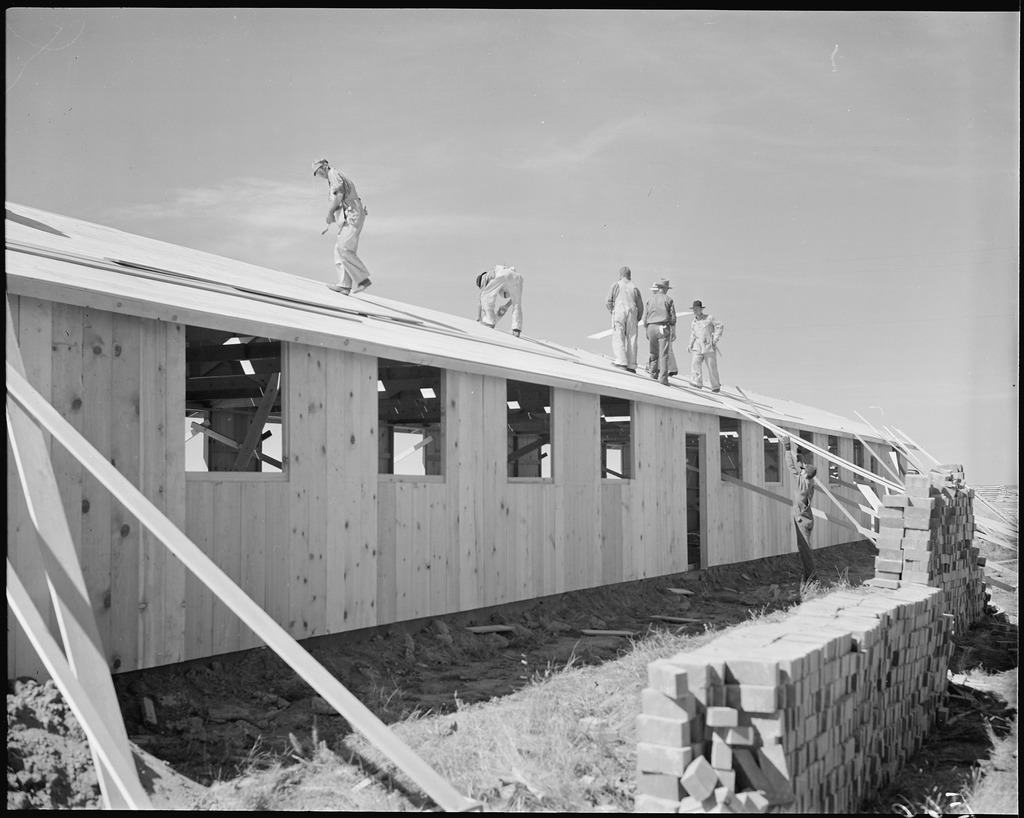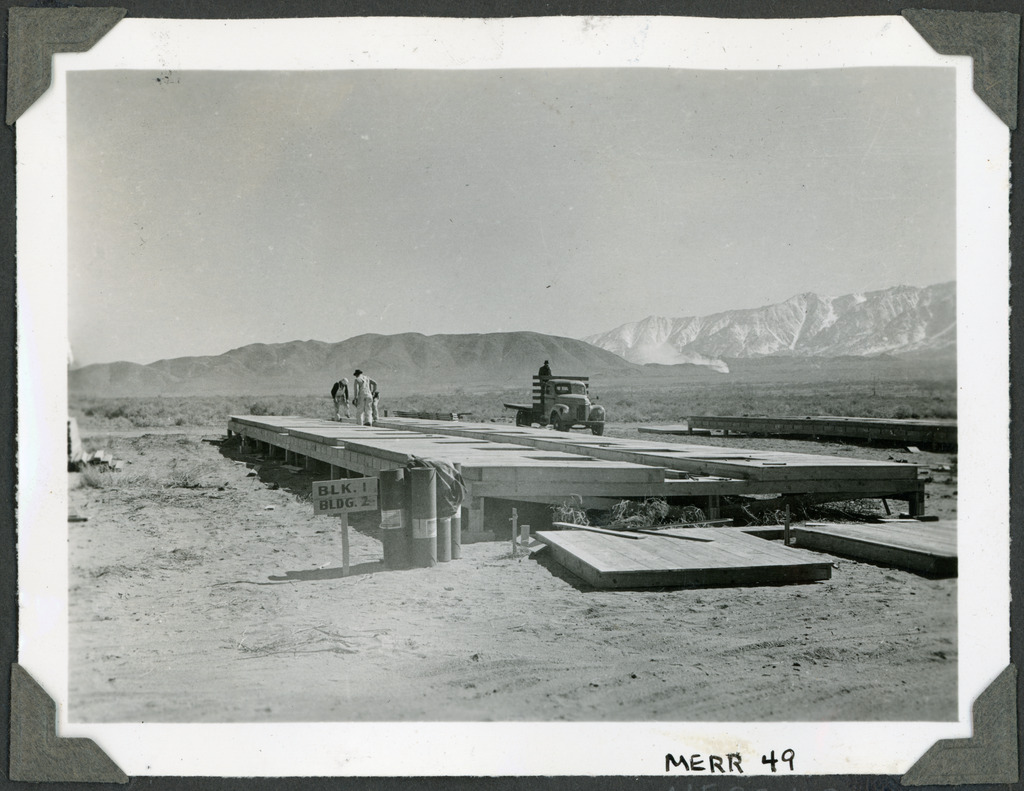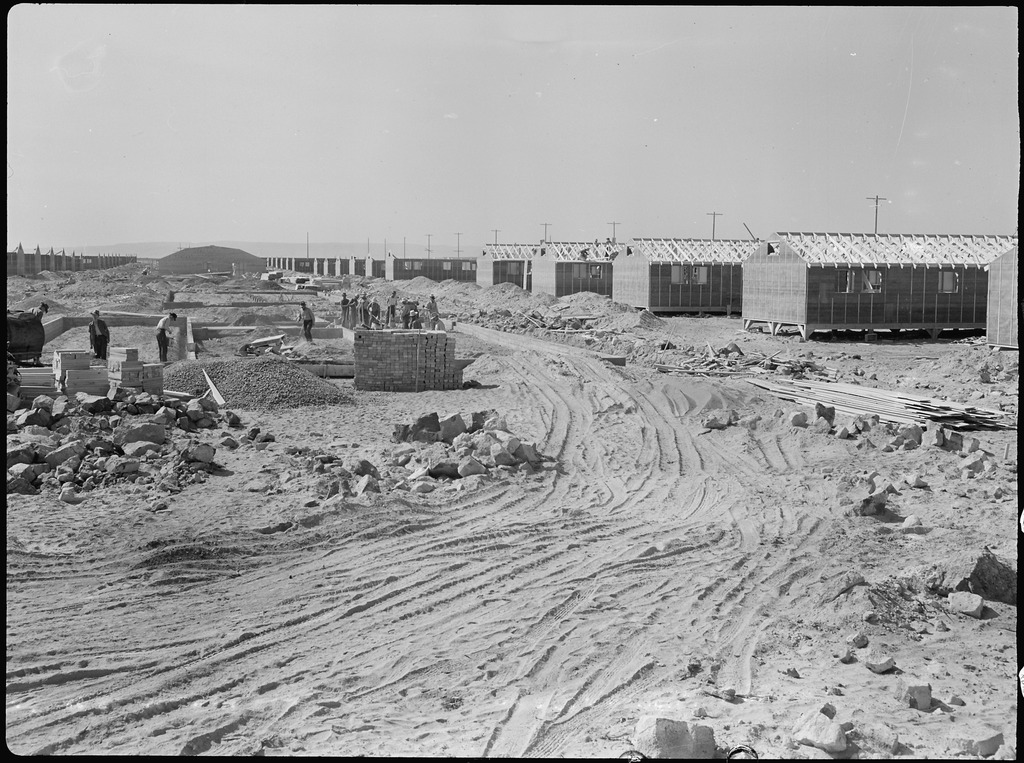November 14, 2023
Densho Content Director Brian Niiya answers a question about the origin of the concentration camps where Japanese Americans were imprisoned during World War II.
What I have tried to look up, but cannot find any answer to, is… when did America start building the camps? I cannot believe that they just sprung up over a few months’ time after Pearl Harbor. They were quite makeshift, true, but some of the places were enormous. Just to find lumber, nails, workers, etc. for such huge places.
I question, were these camps somehow in the planning stages many years before they were occupied? Who designed them? Maybe they were patterned after migrant work camps?
For the most part, the concentration camps that held Japanese Americans were not planned prior to the war. Rather, they were built in a matter of weeks and even days in some cases. Such haste contributed to the inevitably unfinished state of these camps as the excluded Japanese Americans began to arrive. In designing and building these camps, the relevant agencies used existing facilities to the extent possible and also repurposed existing plans for the newly built structures.
Before we get to the larger story of the mass removal of West Coast Japanese Americans, a quick word about the roundup of Issei community leaders that began right after the attack on Pearl Harbor. That roundup had been planned for years in anticipation of war between the US and Japan, and custodial detention lists and existing detention facilities allowed for a roundup and imprisonment of Issei leaders in such places as Missoula, Montana and Bismarck, North Dakota, that started as the smoke from the Pearl Harbor attack still smoldered.
But as many of you reading this will know, this limited roundup was not enough for West Coast political and business leaders or for the Western Defense Command. The War Department and the army convinced President Franklin D. Roosevelt—over the objections of his Justice Department—to issue the infamous Executive Order 9066 on February 19, 1942, which ultimately authorized the expulsion of all Japanese Americans living on the West Coast.

The initial plans for removing Japanese Americans from restricted areas on the West Coast—an area that eventually came to include all of the state of California, the western halves of Washington and Oregon and a southern strip of Arizona—called for “voluntary evacuation” wherever possible and did not envision mass confinement.
Even though problems with “voluntary evacuation” quickly made themselves evident, the government still believed in early March that “half or more of the population” affected by exclusion would be able to move themselves. To deal with the other half, the WDC had by March 12 acquired sites for two large camps—what would eventually become Manzanar and Poston—that would be “conceived as way stations from which the Japanese would be free to depart eastward as soon as they had secured jobs.”1
Meanwhile, the War Relocation Authority (WRA), formed by Executive Order 9102 on March 18, 1942, considered various proposals for taking care of those expelled from the coast, including plans for a series of smaller “way stations” and work camps located throughout the country that could temporarily aid in the resettlement of Japanese Americans in areas outside the West Coast.
But by the end of the month, the continued slow pace of “voluntary evacuation”—along with growing resistance from neighboring states—led to its cessation. Public Proclamation No. 4, issued on March 27, prohibited further movement by Japanese Americans.
As the WDC began issuing exclusion orders starting at the end of March, the Wartime Civil Control Administration (WCCA) scrambled to open the “reception centers.” It also began acquiring existing facilities—fairgrounds, horse racing tracks, migrant labor camps, even a livestock pavilion—in the general vicinity of Japanese American populations that could quickly be converted into temporary “assembly centers” to hold the excluded Japanese Americans.
It is hard to overstate just how quickly this happened. At the Owens Valley site in central California—what would eventually become Manzanar—lumber began arriving on March 14 and the first building went up three days later. The first Japanese American “volunteers” arrived on March 21. By April 11—just three weeks later—there were over 3,300 Japanese Americans there.

As you can imagine, the early arrivals found terrible and unfinished conditions. They were housed in barracks that lacked windows and in blocks where plumbing had not been installed. An outhouse was “hooked up and dragged back and forth between barracks,” and flowed into “an open ditch.”2 Construction workers at the site obscenely harassed inmate women and children.
It was much the same with the “assembly centers.” Take the case of Santa Anita, the first to open. The WCCA leased the horse racing track in mid-March 1942 and construction to renovate the stable area and build what would become 582 barracks began on March 20. The first large group of 587 inmates arrived on April 3, just two weeks later. At Tanforan, construction began on April 7 and the first inmates arrived on April 28. The lease for Portland was signed on April 1, and the first inmates arrived on May 2. This story of startlingly quick construction and unfinished camps when inmates arrived recurs at the other “assembly centers.”
As the first “assembly centers” were opening, the WRA’s vision was still that much of the excluded population would be able to move inland from these temporary facilities, perhaps to smaller work camps. However, WRA Director Milton Eisenhower’s meeting with western state governors in Salt Lake City on April 7, put an end to that scenario after they expressed vociferous refusal to permit resettlement in their states unless in camps under armed guard. Since the army would only agree to guard compounds holding 5,000 or more people (since it would be too costly to guard a larger number of smaller camps), a shaken Eisenhower announced on April 14 a plan to build large guarded compounds to hold excluded Japanese Americans on a long-term basis. The WRA concentration camps would soon follow.
Over the next month or so, sites for eight camps were decided on, along with the conversion of the “reception centers” in central California and Arizona into Manzanar and Poston, bringing the total to ten. The US Army Corps of Engineers was tasked with building the camps, and to speed up the process, used existing 1938 designs for “theater of operations” army barracks as the basis for inmate housing. Some other aspects of the WRA camps came from designs by the Farm Security Administration.3
As with the “assembly centers,” the WRA camps were built very quickly, so as to be able to hold Japanese Americans transferred starting in the late summer and into the fall of 1942. WRA camps were in various states of (in)completion when the inmates arrived, with Japanese American inmate workers often tasked with finishing up. Despite the initial intent to avoid mass confinement, Japanese Americans excluded from the West Coast found themselves incarcerated in concentration camps patrolled by armed guards by the end of 1942.
—
By Brian Niiya, Densho Content Director
[Header: Minidoka concentration camp under construction in August 1942. Photo by Francis Stewart, courtesy of the National Archives and Records Administration.]
References
- Ruth McKee, “History of WRA,” c. 1944. ↩︎
- Manzanar Free Press, March 20, 1943, 3. ↩︎
- See Carol Lynne Horiuchi’s “Dislocations and Relocations: The Built Environments of Japanese American Internment” (Ph.D. dissertation, University of California, Santa Barbara, 2005) for more on the design of the WRA buildings and of the of FSA architects. ↩︎

